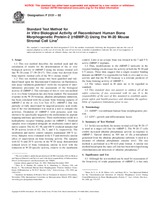Wir benötigen Ihre Einwilligung zur Verwendung der einzelnen Daten, damit Sie unter anderem Informationen zu Ihren Interessen einsehen können. Klicken Sie auf "OK", um Ihre Zustimmung zu erteilen.
ASTM F2131-02
Standard Test Method forIn Vitro Biological Activity of Recombinant Human Bone Morphogenetic Protein-2 (rhBMP-2) Using the W-20 Mouse Stromal Cell Line
Automatische name übersetzung:
Standard Test Method FORIN Vitro Biologische Aktivität von rekombinantem Human Bone Morphogenetic Protein -2 ( rhBMP-2 ) Unter Verwendung der W-20 -Maus Stromazelllinie
NORM herausgegeben am 10.9.2002
Informationen über die Norm:
Bezeichnung normen: ASTM F2131-02
Anmerkung: UNGÜLTIG
Ausgabedatum normen: 10.9.2002
SKU: NS-52937
Zahl der Seiten: 6
Gewicht ca.: 18 g (0.04 Pfund)
Land: Amerikanische technische Norm
Kategorie: Technische Normen ASTM
Die Annotation des Normtextes ASTM F2131-02 :
Keywords:
in vitro bioactivity assay, recombinant human bone morphogenetic protein, W-20 cell line, ICS Number Code 07.080 (Biology. Botany. Zoology)
Ergänzende Informationen
| 1. Scope |
|
1.1 This test method describes the method used and the calculation of results for the determination of the in vitro biological activity of rhBMP-2 using the mouse stromal cell line W-20 clone 17 (W-20-17). This clone was derived from bone marrow stromal cells of the W++ mouse strain. 1.2 This test method (assay) has been qualified and validated based upon the International Committee on Harmonization assay validation guidelines (with the exception of interlaboratory precision) for the assessment of the biological activity of rhBMP-2. The relevance of this in vitro test method to in vivo bone formation has also been studied. The measured response in the W-20 bioassay, alkaline phosphatase induction, has been correlated with the ectopic bone-forming capacity of rhBMP-2 in the in vivo Use Test (UT). rhBMP-2 that was partially or fully inactivated by targeted peracetic acid oxidation of the two methionines was used as a tool to compare the activities. Oxidation of rhBMP-2 with peracetic acid was shown to be specifically targeted to the methionines by peptide mapping and mass spectrometry. These methionines reside in a hydrophobic receptor binding pocket on rhBMP-2. Oxidized samples were compared alongside an incubation control and a native control. The 62, 87, 98, and 100 % oxidized samples had W-20 activity levels of 62, 20, 7, and 5 %, respectively. The incubation and native control samples maintained 100 % activity. Samples were evaluated in the UT and showed a similar effect of inactivation on bone-forming activity. The samples with 62 % and 20 % activity in the W-20 assay demonstrated reduced levels of bone formation, similar in level with the reduction in W-20 specific activity, relative to the incubation control. Little or no ectopic bone was formed in the 7 and 5 % active rhBMP-2 implants. 1.3 Thus, modifications to the rhBMP-2 molecule in the receptor binding site decrease the activity in both the W-20 and UT assays. These data suggest that a single receptor binding domain on rhBMP-2 is responsible for both in vitro and in vivo activity and that the W-20 bioassay is a relevant predictor of the bone-forming activity of rhBMP-2. 1.4 The values stated in SI units are to be regarded as standard. 1.5 This standard does not purport to address all of the safety concerns, if any, associated with its use. It is the responsibility of the user of this standard to establish appropriate safety and health practices and determine the applicability of regulatory limitations prior to use. |
Empfehlungen:
Aktualisierung der Gesetze
Wollen Sie sich sicher sein, dass Sie nur die gültigen technischen Vorschriften verwenden?
Wir bieten Ihnen Lösungen, damit Sie immer nur die gültigen (aktuellen) legislativen Vorschriften verwenden könnten.
Brauchen Sie mehr Informationen? Sehen Sie sich diese Seite an.




 Cookies
Cookies
